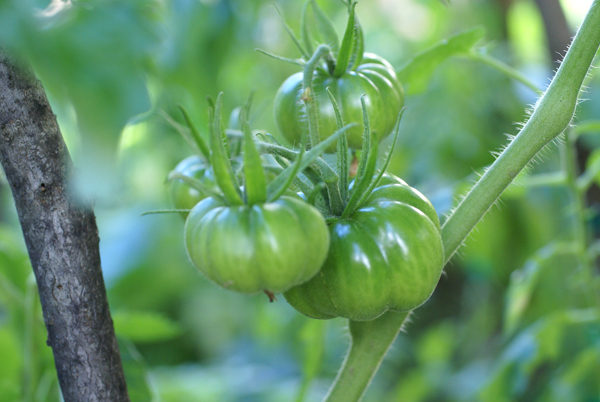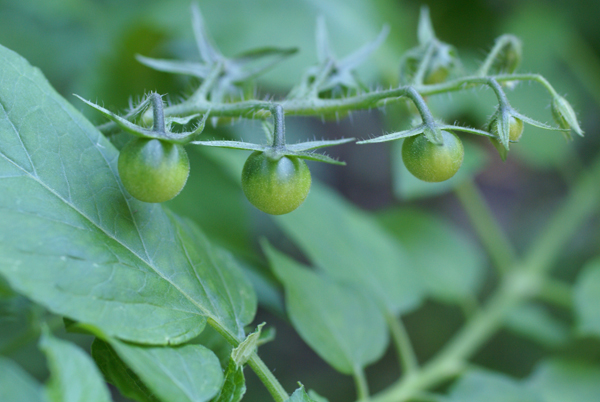Choosing the best fertilizer for your tomato plants can be completely overwhelming. There are so many different kinds of fertilizers and each type has its fair share of variety. Rest assured, there’s no need to throw your hands up in frustration. I’m going to lay it all out for you, and we’ll get through it together.

How to fertilize tomatoes
As a natural and organic gardener, I must say that the best thing you can do for your tomatoes is to start them off right with soil that is rich in organic matter. Tomatoes are heavy feeders, so they’ll need plenty of compost, worm casings or manure in the soil before you even get started. If you’re planting your tomatoes in a garden bed, plan to start readying your soil a few weeks before you want to plant.
It’s helpful to get a PH test of your soil before you begin so you’ll know what your garden bed is lacking and what you’ll need to add to truly take care of your tomatoes. Tomatoes thrive in soil that is slightly acidic, at a PH of 5.5-6.8.
Once you know what to add to your soil, you can choose fertilizer.
Chemical fertilizers
Chemical fertilizers are widely used for good reason: they work. These can come in the form of sprays, liquid or granules. Chemists have spent decades coming up with the perfect ratios of nutrients to douse your lovely plants that will result in the perfect, juicy tomato. Chemical fertilizers are formulated to absorb quickly into the plant and give the perfect ratio of nutrients at the same time. There is a downside to these fertilizers — they can be expensive and can contain inorganic materials that can turn away healthy microbes and insects in the soil. If you do choose a chemical fertilizer for your plants, go with one specially formulated for tomatoes or one labeled 5-10-10.
Organic Fertilizers
Organic fertilizers include anything that can improve plant health and is naturally derived from the Earth. Fish emulsion, blood and bone meal, liquid seaweed, and manure are all examples of organic fertilizers. These ingredients are often pre-mixed to perfect ratios and waiting for your eager hands at your local garden supply shop. Great for your soil, great for your plants, and great for you!
Compost
The wonderful thing about compost is it’s free and you know exactly what went into it. The not so wonderful thing about compost, it takes time to make and it takes time to work its magic on your plants. Many gardeners mix compost into their garden beds to improve the soil structure and add organic matter for plants to feed on. This method depends entirely on the amount of compost used and its nutrient makeup. If compost isn’t enough, compost tea works wonders as a supplement in times of need.
You might also enjoy our post on things you can’t compost.
Compost tea
Compost tea sounds a lot more delicious than it actually is. Soaking compost in a large bucket of water makes compost tea. The compost is then filtered out and the remaining tea, which is chock full of nutrients, is used to water plants. Making compost tea can be a quick fix and an organic method to help plants in need. The downside is it’s not a perfect science and your compost may not have the perfect nutrient balance to help your problem.
When to fertilize
Before planting
A few days to a few weeks before planting, go ahead and mix some fertilizer into the soil of your tomato bed. This works best with compost, worm casings or manure.
During first flowering
Give those babies some extra phosphorus and potassium to help the flowers and fruit develop. Don’t make the mistake of adding extra nitrogen at this point, as it will only aid in creating more leaves for a plant that needs to focus on fruit.
Supplemental
If you notice your plant is struggling in any way, and you’ve eliminated any issues with light or watering, it may be time to feed it. Tomatoes are heavy feeders and need more nutrients than the average plant, so you’ll need to know the signs for when your plant is in trouble, and how to fix it.

How to tell if your tomato plant is lacking in nutrients
- Yellowing of leaves or small leaves
- Leaf and stem growth is stellar, flower and fruit growth is nil: too much nitrogen
- Leaves are dark green or curling at the edges
- Lower leaves are dark green and curling at edges
If you notice your plant is in a dire condition and needs immediate help, skip the compost or granulated fertilizers and go straight for the liquid stuff.
When it comes down to it, choosing fertilizer for your tomatoes is a personal preference. If you’re looking to grow your gardens as naturally and organically as possible, compost and aged manure can work wonders. Others find that they’re better off with the ease of liquid and granulated fertilizers. Whatever works for you in the end is fine, as long as you get to enjoy the harvest from your delightful plants.

Can any types of tomatoes grow with only 3 hrs sunlight in Orlando, Florida?